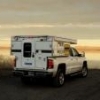With reference to the original thread link, at the top of this thread link, I chose this one for revival due to the brevity. I am looking for any advice/logistics/help for A-Z planning that can be offered. I have received a very helpful PM so far. Here are my particulars ...
ETA early April I for my Grandby Shell from FWC. It will have the std. single battery Shell setup with a fuse box & battery separator in the Shell (so I am told), w/alternator hook up, no other electronics, no solar anything. I will replace the std. existing battery with one LiFePo4 12V 100ah. My power needs will be 12V. I plan on two 100W flex panels on roof & one 100W portable for camp. I want to stay light.
My power needs: two F fans (with altered diy variable speed fan control), interior LED lighting, std. FWC propane heater fan, Engel or similar fridge, cell phone & tablet charging, rare occasion exterior rear flood lighting.
With hopefully the same ETA, I will own a 2018 F-150 with optional interior 110v/400w, AC plug in, outlet. With these variables, I would like to KISS for myself, but most importantly, keep my solar system healthy. Monitor for capacity coupled with real time in & out. I am trying to read & learn but not in my wheelhouse. I would welcome any thoughts or design on needed components, gauges. Starting from scratch.
Thanks - Mark ..... Can not wait for my traveling tent, (tent & backpack lifer) with benefits, to start adventures. My wife is ready to go too.
100AH LiFePo4 sounds like lots of (House) battery for the listed items that will draw power.
KISS would be to NOT count on the truck to charge the house battery. That way you don't need to worry about upgrading the wires from the alternator to house batteries, or figuring out how to control the charge the house batteries are getting from the alternator.
That requires that you will get enough solar to charge the batteries.
Which means we need to know a bit more about your camping habits:
- where do you camp? Latitudes, amount of sunshine, shade from trees/mountains
- how many days at time are you camping?
- can you count on getting a good charge every day?
- if not, how many days between good charge opportunities?
This latter info is important because you only have about 90 useable AH. Your draw will be around 30-50 AH a day, meaning you have only have enough AH for 3 days at best.
Assuming you get to 50% SOC often, you will want to be able to get 50AH back in a day, using solar (or 120v if available) only.
Your 300W of available solar power translates to about 240W at best (80%) of actual output. 240W @ 14.6V (LiFePo4 recommended charging voltage) = 16.4A... this is how much current you want your solar controller to be able to put out.
50AH at 16.4A = 3 hours of charging at full/max power output. Most days you will not get 3 hours of perfect sun at the perfect angle. However, you are certainly in the ballpark for being able to recharge your house batteries daily.
A Victron 75/30 controller and BM712 battery monitor would be a great addition to this setup for charging and monitoring your batteries.
















